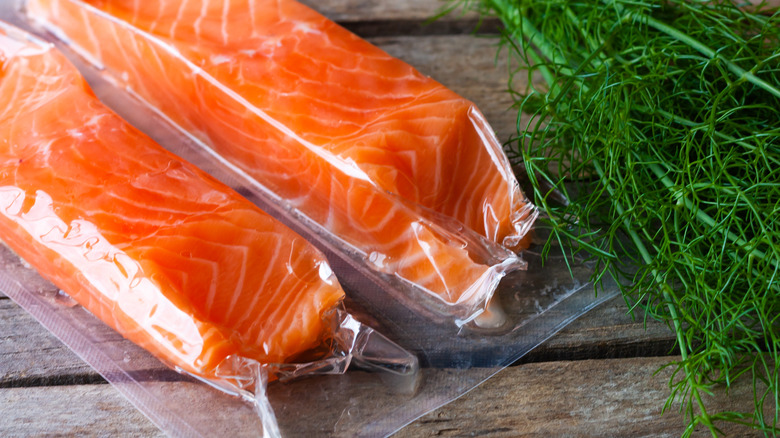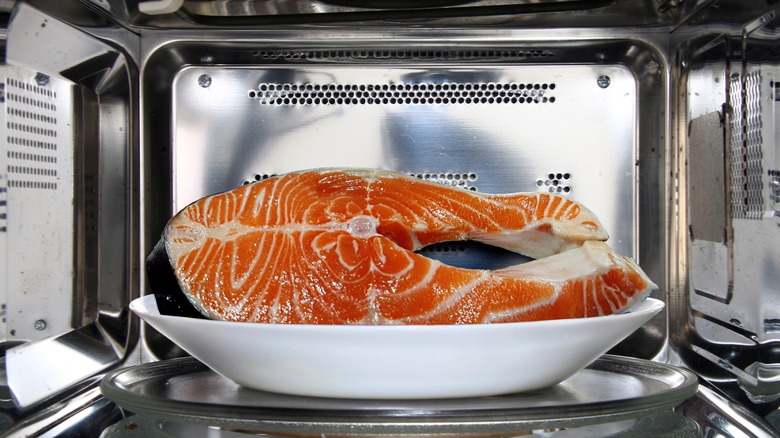The Huge Mistake You Should Avoid When Thawing Frozen Fish
Some people prefer to cook fish straight from the freezer. This practice can save you time and effort, but you might end up with a soggy mess — especially when cooking oilier fish like tuna, salmon, or sardines. Your best bet is to thaw the fish, even if that means waiting a little bit longer to get your meal ready. But first, there are a couple of steps you must take to avoid bacterial growth and other food safety risks. For example, you should always remove the fish from its vacuum packaging before thawing it.
Manufacturers use vacuum sealing to extend food shelf-life and prevent spoilage. This packaging method involves removing the air from sealed bags to reduce moisture loss and keep your food from drying out. It also prevents cross-contamination during transportation and storage, which in turn may increase food safety. However, some pathogens can only grow in the absence of oxygen. An example is Clostridium botulinum, an anaerobic bacterium that produces neurotoxins.
In some cases, this microorganism can contaminate vacuum-sealed fish without causing visible spoilage, warns the U.S. Food and Drug Administration (FDA). If ingested, it may cause a potentially fatal disease called botulism. Thawing frozen fish in its vacuum packaging can increase the risk of contamination because C. botulinum thrives at temperatures above 38 degrees Fahrenheit.
Why you should never defrost vacuum-sealed fish
Most refrigerators are set to 37 to 40 degrees Fahrenheit, a temperature that's low enough to kill most germs. The problem is that C. botulinum can form and spread in oxygen-deprived environments (such as vacuum bags), even at low temperatures. Therefore, thawing vacuum-sealed fish in the fridge or under running water can lead to foodborne illnesses, particularly botulism. The same can happen when canning food at home or eating from dented cans.
The toxins produced by C. botulinum attack the nerves responsible for muscle movement, which may result in immobility. The first symptoms kick in within 12 to 36 hours after eating contaminated food and may include nausea, vomiting, shortness of breath, poor muscle control, and overall weakness. Some people may also experience diarrhea, slurred speech, difficulty swallowing, and vision problems. As the disease progresses, it may cause paralysis of some or all muscles, including those involved in breathing.
C. botulinum can survive freezing temperatures, too. This means you can get sick from eating vacuum-sealed fish that hasn't been properly stored before freezing. There's also a risk of contamination with Listeria monocytogenes, a bacterium that can grow on vacuum-sealed meat and fish products stored at temperatures between 39 and 41 degrees Fahrenheit or higher.
How to safely thaw vacuum-sealed fish
Unfortunately, there's no surefire way to prevent botulism. The best thing you can do is learn how to correctly (and safely) defrost salmon, tuna, and other fish. If you buy it in vacuum-sealed bags, let it thaw in the fridge only after removing the packaging. Place it in a food container away from other foods to avoid cross-contamination. As a rule, you should never thaw fish or meat products at room temperature.
Alternatively, discard the packaging and defrost the fish in the microwave or under cold running water. These methods are quick and convenient but not as safe as refrigerator thawing. In either case, it's recommended to cook the fish immediately or refrigerate it for no more than two days.
Cooked fish and seafood can be stored in the freezer for one to two months. An even better option is to use the leftovers in salads, sandwiches, casseroles, and other cooked meals. For example, leftover salmon can be a delicious addition to quesadillas, frittatas, Thai fishcakes, pasta dishes, or fried rice.


